新教材七年英语下unit2period2
人教版七年级下Unit2SectionBperiod2练习测试含答案

人教版七年级下Unit2SectionBperiod2练习测试含答案Unit2 Section B period 1 Section B 1a-1e 练习测试一、根据句意及首字母补全单词。
1. What t_______ do you get up?2. He u_______ goes to school by bus.3. I brush my t_______ every day. So they are white.4. He likes to take a s_______ before he goes to bed.5. Scott g_______ up early every day.二、单项选择。
1. I usually _______ the No. 12 bus to school.A. takeB. bringC. needD. have2. Mr. Wang works hard. Sometimes he works _______.A. all nightB. all a nightC. the all nightD. all nights3. _______ Sunday morning, I usually eat breakfast _______ seven o’clock.A. On; atB. On; inC. In; atD. In; on4. There are sixty minutes in _______.A. a dayB. an hourC. a weekD. a month5. _______ mother takes _______ to school every day.A. Her; herB. She; herC. His; herD. Her; him三、用括号内所给词的适当形式填空。
Scott (1)_______ (work) very long hours. He usually (2) _______ (get) up at 7:00. He (3)_______(have) a shower and (4) _______ (make) his breakfast. What a funny time (5) _______ (have) breakfast! After breakfast he (6) ______ (practice) his guitar, then he (7) _______ (put) on his jacket and (8) _______ (go) to work. (9) _______ (get) to work, he (10) _______ (take) the No. 17 bus to the Santon Hotel. The bus usually (11) _______ (leave) at 19:15. He (12) _______ (work) all night. People (13)_______(love) (14) _______ (listen) to him. He (15) _______ (get) home at 7:00, and he (16) _______ (watch) the early morning news on TV. He (17) _______ (go) to bed at 8:30, a tired but happy man. Can you (18) _______ (think) what his job is?四、单句改错。
人教版新目标英语七年级下册unit2全单元教案

Unit 2 Where is the post office?Language goals:●In this unit students learn to talk about asking for and give directions on thestreet.New languages:●Excuse me, is there a bank near here?●Y es, there is. It’s on Center Street.●Where is the pay phone?●It’s across from / next to / in front of / behind the library.●It’s between the post office and the library.●Just go straight and turn left.●Turn left on First Avenue.●T ake a walk through the park on Center Avenue.●There is a clean / dirty park near my house.Difficult points:1. Listening for the information of the names of the neighborhoodRead the tour guide and an e-mail from a friend you’re going to visit.Write the dialogues about asking the way and giving directions.2. Where questions.Affirmative statementsPrepositions of placeTeaching aids:● A tape recorder●Some picturesTeaching periods:Period 1: Section A1a, 1b, 1cPeriod 2: Section A2a, 2b, 2cPeriod 3: Section A3a, 3b, 4Period 4: Section B 1a, 1b, 1c, 2a, 2b, 2cPeriod 5: Section B 3a, 3b, 3c, 4Period 6: Self CheckTeaching aims:1. T each vocabulary words.2. T arget languages: Is there a bank near here? Y es, there is. It’s on CenterStreet.3. Enable the students to ask for and give directions on the street.4. Help the students to ask for and give directions on the street.Teaching procedures:Step 1. Warming upShow three pictures prepared before class to the students. There is acat in a box in picture 1. There is a cat on a box in picture 2. There is acat under the box in picture 3.Then ask some students to ask and answer these questions.Step 2.Match work (2a)Ask the students to read the picture and the words in the numbered list.Ask the students to match each word or phrase on the list with one of the pictures.Then check the answers.Present the new sentence patterns.Then ask the students to read the dialogue in the picture.Step 3. Listening (1b)Ask the students to listen to the conversations and circle the places in 1a.Change the roles and do the same again.Then students ask and answer without the help of the recording.Step 4. PracticePoint to the different locations shown in the picture. Ask different students to name each one.Then point to more locations and let the students to practice more.Homework1. Practice the conversation in the picture on page 7.2. Learn the new words and phrases in this period by heart.Teaching aims:1. Learn the vocabulary words and useful expressions.2. T arget languages:The pay phone is across from the library.The pay phone is next to the library.The pay phone is between the post office and the library.The pay phone is on Greet Street.The pay phone is in front of the library.The pay phone is behind the library.3. Enable the students to talk about the position of a place.4. Help the students to talk about the position of a place.Teaching procedures:Step 1. Revision and warming upCheck the homework by talking about the pictures on page 7 with thestudents or prepare some other pictures with different buildings in itand let the students practice asking and answering questions aboutthe places.Ask the students to practice more.Step 2. Presentation (2a)Introduce the items across from, next to, between, in front of, behindand on.Draw the following picture on the blackboard.Park 3 Centre StreetEncourage or help the students to answer: It’s across from the library.The same way goes with next to, on and in front of.Ask the students to match each sentence with one of the pictures.Then ask the students to read the six sentences and match thesentences the pictures.Check the answers.Step 3. Listening(2b)Review the buildings and street names in Activity 1a and the sixsentences in 2a.The read the six sentences in 2b to the class.Ask the students to listen to the recording and fill in the blanks.Play the tape. Check the answers.Step 4. Practice (2c)Ask the students to repeat the conversations after the recording.Ask the students to do the Pair work asking and answering questionsabout the places in 1a.Step 5.Grammar FocusAsk the students to read the sentences in the grammar box aloud. Theask them to answer the following questions. Explain some languagepoints if t he students can’t understand.HomeworkAsk the students to practice talking about their neighborhood in pairs.Period 3T eaching aims:1. T each vocabulary words.2. T arget languages:Just go straight and turn left.It’s down Bridge Street on the right.It’s next to a supermarket.3. Enable the students to talk about the neighborhood.4. Help the students to talk about the neighborhood.Teaching procedures:Step 1. RevisionLet the students look at the picture in activity 1a. And ask somestudents to answer some questions in order to check the homework.Say, Is there a library near here? Where is it? Is there a bank near here?Where is it?Put up the picture of activity 2a on the blackboard and ask them tomake conversations.Step 2. Presentation (3a)Guide the students to guess the meanings of the three traffic signs.Show the pictures and ask some questions about the pictures.Then ask the students to hold up their left hands and then their righthands to practice “left” and “right”.Point to the picture and let the students read the conversation.Ask the students to read the conversations. Then ask them to find Pauland Nancy in the picture.Ask the students to role play the conversation then point out the placethat Paul wants to get to.Step 3. Complete the conversations (3b)Ask the students to make conversations and answer the questionsbelow each picture.The students point out the place in the picture. And write down theanswers on the line in the pictures. Or ask a pair of students to say theconversation, the others point to the speakers’ place.Step 4. GameAsk the students to look at the picture in Activity 1a and name all the buildings.Ask some students to read the conversation in the picture in Activity 4.And then explain the instruction to the student.Then ask some groups to present their work.HomeworkAsk the students to make a similar conversation to that in Activity 3a. Period 4Teaching aims:1. T each vocabulary words.2. T arget languages:Is there a big supermarket near your house?Y es, there is.There is a big supermarket.No! There is a small supermarket.3. Enable the students to describe the neighborhood.4. Help the students to describe the neighborhood.Teaching procedures:Step 1. RevisionCheck the homework by asking the following questions.Say, Look at the picture in activity 3a. Suppose you are standing nearthe building on the side of New Street. Please answer my questions.Excuse me. Is there a pay phone in the neighborhood?Ask another student to answer questions.Give more students chances to practice this dialogue.Step 2.Match work (1a)Bring in some objects or pictures to the students. (Two rulers, one is old,the other is new. Two boxes, one is big and the other is small. Two bottles, one is clean and the other is dirty. Two pictures of a street, one is busy and the other is quiet.)Say, Look at the rulers, please. Can you find the difference between them? Y es. This one is old. (Show the old ruler.) And this one is new.(Show the new ruler.) Do you understand old and new?Ask the students to talk about the picture.Point to each half of each picture and ask about the difference between the halves.Go on with the other pictures to teach the language items.Ask the students to match the words with the pictures.Step 3. Pair workCall attention to the conversation in the picture.Then ask the students to work in pairs and take turns asking each other questions about the things on the list of phrases in activity 1a on page 7. Step 4. Listening (2a, 2b)Ask the students to listen to the tape and circle the places in 1a.Say: Now please listen to the tape again. Listen to it and draw the places in Michael’s neighborhood on the street map. Just listen.Play the recording.Play the recording again.Then have some students show their completed drawing to the class. Step 5. Pair workAsk the students to work in pairs talking about drawings to the class.Then ask some pairs to present their dialogues to the class.Ask the students to work in pairs, draw a map of their own neighborhood and practice asking and answering questions about the places they live in.HomeworkAsk the students to make similar conversations to that in Activity 1b.Period 5Teaching aims:1. T each vocabulary words.2. T arget languages:Turn left on First Avenue and enjoy the city’s quiet streets and small parks.T ake a walk through the park on Center Avenue.This is the beginning of the garden tour.Bridge is a good place to have fun.3. Enable the students to write a tour guide and draw the rout to somewhere.4. How to write a tour guide and draw the rout to somewhere.Teaching procedures:Step 1. RevisionCheck the homework by asking about the student’s neighborhood.Ask the students to work in pairs.Ask the students to work in pairs.Then ask some pairs to present their conversations to the whole class.Step 2. Reading (3a, 3b)Ask the students to read the tour guide.Divide the whole class into four groups to have a quiz.T ell the students to keep these words down and make at least two sentences with each word after class.After that ask the students to look at the pictures and fill in the blanks for this tour guide.Step 3.WritingAsk the students to write a tour guide with the students.Names of buildings and locations.Description wordsWords that talk about positions.Words that talk about directions.Step 4. Pair work (4b)Learn to draw a picture of neighborhood. First ask the students toanswer the questions according to the pictures.Then ask the students to draw a picture according to the followingconversation.Then ask students to present their drawings to the whole class.Homework1. Ask the students to talk about the street and buildings in their ownneighborhood.2. Ask the students to make sentences with the description words they keptdown in the class.Period 6Teaching aims1. T each vocabulary words.2. T arget languages:I know you are arriving next Sunday.Let me tell you the way to my house.I hope you have a good trip.3. Enable the students to write about the neighborhood.4. Help the students to learn how to write about the neighborhood.Teaching procedures:Step 1. RevisionCheck the homework by asking and answering some questions.Give more students chances to practice.Step 2.Key word check(1)Ask the students to check the words they know.Then ask the students to do the some exercises.Step 3.Vocab-Builders (2)Expand the students’ vocabulary.After that ask the students to share their list with other students.Step 4. ReadingAsk the students to read the letter and draw the rout on the map.Ask the students to change the letter into a telephone conversation.Let the students pay attention to the pictures.Say, Look at the picture of Sally. How old do you think she is? Where do you think she is from? What language do you think she speaks? What do you think she likes?What do you think she dislikes?The same step goes with Jim and Julie.After a few minutes, ask some students to read their descriptions to the class.Step 5. Just for Fun!Call attention to the conversation in the cartoons.Ask the students to read the conversation and then answer the questions.HomeworkAsk the students to do the following:1. Suppose your friend is going to visit you. He doesn’t know the way toyour house. Write a letter to him to tell him the route from the bus stop to your house.2. Review the next unit.。
新版(人教版)七年级(下)英语Unit2课文详解

新版(人教版)七年级(下)英语Unit2课文详解Unit 2 What time do you go to school?Section A 2a— 2d(P8)* 教师寄语:No man can do two things at once. 一心不可二用。
【学习目标】【学习重点】:1. 熟练掌握本课单词和短语.2. 学会谈论自己及他人的日常生活及日常作息习惯,并能合理安排.【体验学习】:用适当的词填空,补全下面的短文:My DayI usually _____ ____(起床)at 6:30. I have breakfast ______ (在) seven o’clock . After breakfast, I ______ ____ _____(洗澡)and then I ____ ___ ____(上学)at 7:30. I get to school at 7:40. I have five classes in the morning. And then I ______ _____ (吃午饭) at 12:00. In the afternoon, I have two classes. I ____ ______(回家)at 6:20. I get home at 6:30 p.m. I ______ _______(吃晚饭)at about 7:00. After dinner, I do my homework(做作业). I go to bed(睡觉)at 10:00. I am very busy(繁忙的)and happy every day.【课堂导学】:学习任务一:完成活动2a1.听录音,完成2a中的句子。
2.再听一遍录音,自己核实答案。
3.小组相互核对答案,检查所听结果。
4.小组为单位,谈论对话中的内容。
学习任务二:完成活动2b。
1.听录音,完成时间表。
2.再听一遍录音,自己核实答案。
七年级英语下册Unit 2 2教案人教新目标版
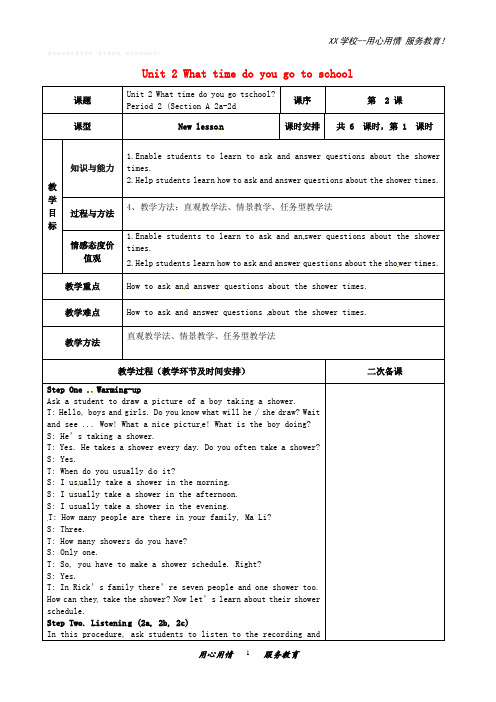
精品基础教育教学资料,请参考使用,祝你取得好成绩!Unit 2 What time do you go to school课题Unit 2 What time do you go tschool?Period 2 (Section A 2a-2d课序第 2 课课型New lesso n 课时安排共 6 课时,第 1 课时教学目标知识与能力1.Enable students to learn to ask and answer questions about the showertimes.2.Help students learn how to ask and answer questions about the shower times. 过程与方法4、教学方法:直观教学法、情景教学、任务型教学法情感态度价值观1.Enable students to learn to ask and an swer questions about the showertimes.2.Help students learn how to ask and answer questions about the sho wer times.教学重点How to ask an d answer questions about the shower times.教学难点How to ask and answer questions about the shower times.教学方法直观教学法、情景教学、任务型教学法教学过程(教学环节及时间安排)二次备课Step One . Warming-upAsk a student to draw a picture of a boy tak ing a shower.T: Hello, boys and girls. Do you know what will he / she draw? Wait and see ... Wow! What a nice pictur e! What is the boy doing? S: He’s taking a shower.T: Yes. He takes a shower every day. Do you often take a shower? S: Yes.T: When do you usually d o it?S: I us ually take a shower in the morning.S: I usually take a shower in the afternoon.S: I usually take a shower in the evening.T: How many people are there in your family, Ma Li?S: Three.T: How many showers do you have?S: Only one.T: So, you have to make a shower schedule. Right?S: Yes.T: In Rick’s family there’re seven people and one shower too. How can they take the shower? Now let’s learn about their shower schedule.Step Two.Listenin g (2a, 2b, 2c)In this procedure, ask students to listen to the recording andfinish Activities 2a and 2b. Then check the answers in the following way.T: You see, Rick’s family is a big one. There’re five children in the family. Do you know who they are?S: They are Rick, Bob, Mary, Jerry and Alicia.T: Very good! From the recording, we know that Bob takes a shower at 5:00. He is the first to take a shower. Then what time do Mary, Jerry, Rick and Alicia take a shower? Please listen again and complete the table in 2b.Then divide students into t wo groups. Ask and answer questions about Rick’s family.Step Four. Pair work Roleplay the conversation in 2dStep Five.Explain some language points.Step Six. Homework1.Ask students to finish the exercises in the Workbook.2. Ask each student to make a clock to get ready for the next class.板书设计I usually take a shower in the morning.I usually take a shower in the afternoon.I usually take a shower in the evening.When does Scott go to work?He always goes to wor k at eleven o’clock. He is never late. That’s a funny time for breakfast.教学反思。
新人教版七年级英语下册Unit2 period2精品课件
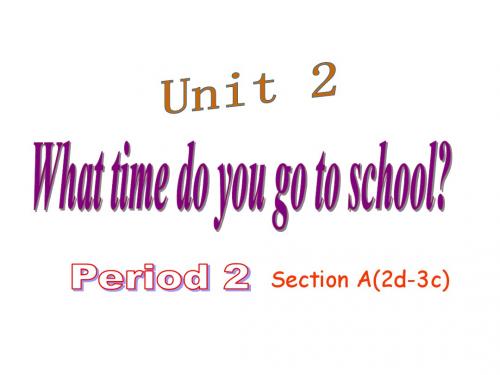
Scott: At eight thirty at night. Then I eat breakfast at night.
Interviewer: That’s a funny time for breakfast! Scott: Yeah. After that, I usually exercise at about ten twenty. Interviewer: When do you go to work? Scott: At eleven o’clock, so I’m never late for work.
Scott: At eight thirty at night. ____________________.
Interviewer: _______________________ breakfast! Scott: Yeah. ______, I usually exercise at about ten twenty. Interviewer: When do you go to work? Scott: At eleven o’clock, so ________________________.
Interviewer: ________ do you go to work?
Scott: At eleven o’clock, so I’m never late ______ work.
2d Role-play the conversation. (Three)
Interviewer: Scott has _____________. He __________. ___________ is your radio show? Scott: ______________________________________. Interviewer: _________________ get up?
七年级新目标下Unit_2_What_time_do_you_go_to_school教案
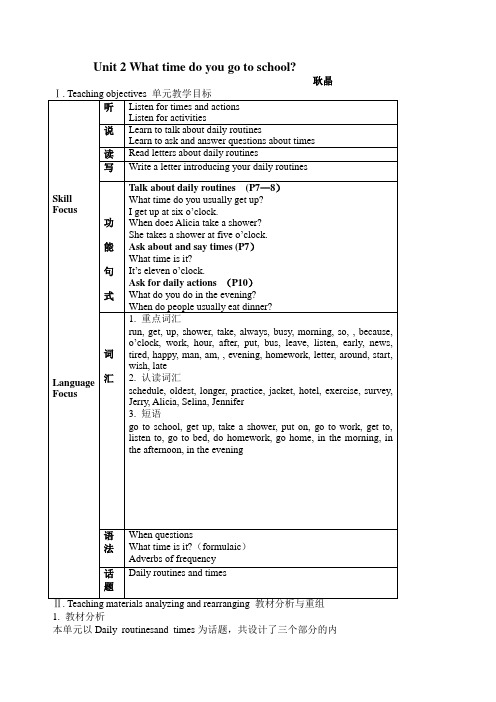
Unit 2 What time do you go to school?耿晶1. 教材分析本单元以Daily routinesand times为话题,共设计了三个部分的内容。
旨在通过单元教学使学生学会谈论日常行为、询问并答复有关时间的问题、询问并回答人们在特定时间所从事的活动。
Section A 学习谈论日常作息时间。
1a, 1b, 1c 重点学习和学生息息相关的几种日常行为的英文表示方法,学会询问和答复日常作息时间。
2a, 2b, 2c ,2d继续学习谈论自己或他人的日常作息时间。
重点学习如何询问,这也是本单元的语法重点。
3a, 3b, 3c 学会叙述他人的日常活动安排,同时学习询问时间和时间表达法,进一步巩固询问别人的日常作息时间的表达法。
Section B 继续学习询问和谈论别人的日常行为。
1a, 1b, 2a, 1c,1d,1e,学会谈论和询问一天内各个时间段的活动安排。
2a,2b,3a,3b学会通过两个人的对比介绍来判断并养成好的作息时间。
Self check 重点单词句型复习2. 课型设计与课时分配Period 1 Listening and speaking (I)(Section A: 1a, 1b, 1c)Period 2 Listening and speaking (II)(Section A:2a, 2b, 2c,2d)Period 3 Integrating skills(Section A:3a, 3b, 3cSection B: 1a, 1b,1c,1d,1e)Period 4 Reading and writing(Section B:2a, 2b, 2c,3a,3b)Period 5 Self checkⅢ. Teaching plans for each periodPeriod 1 Listening and speaking(Ⅰ) Target language目标语言1. Words && phrases生词和短语Up,get up,dress,get dressed,brush,tooth,shower,take a shower,usually,forty, what time,2. Key sentences重点句子When do people usually ...? People usually ...What time do you usually ...? I usually ...Ability goals能力目标Enable students to learn to talk about daily routines.Learning ability goals学能目标Help the students learn how to talk about daily routines.Teaching important / difficult points教学重难点How to talk about daily routines.Teaching aids教具准备A tape recorder and a model clock.Teaching procedures and ways教学过程与方式Step ⅠWarming upIn this procedure, motivate students to learn some words and phrases by singing the songs they’ve learned before.T: Good morning, everyone. (sing) “Good morning to you. Good morning to you. Good morning, dear children. Good morning to you.” This song is easy to learn. Who can sing it to us?Encourage students to sing the song.T: Well done. Thank you! We sing “Good morning to you” in the morning. Then what do we sing in the afternoon and in the evening? S: We sing Good afternoon to you in the afternoon and Good evening to you in the evening.T: That’s right. I know all of you are very good at singing. Does anyone want to sing Good afternoon to you or Good evening to you to us?Step ⅡTalking and reading (1a)In this procedure, ask students to finish the required task and learn some key phrases about daily actions.T: As we all know, time is very important and in English there is a famous saying "An hour in the morning is worth two in the evening." So what do you do in the morning?S1: I read English. S2: I do morning exercise.T: And what do you do in the afternoon and in the evening?S1: I play basketball in the afternoon. S2: I watch TV in the evening.T: I’m very glad to hear that. You use your time very well. And there’re many daily things we can do. Now let’s read these phrases in 1a and match these actions and the time of day.Step ⅢPracticeIn this procedure, students will learn how to talk about actions and the time of day.T: I know you’re very clever. Now I want you to tell if my statements are right or wrong. First, I usually eat dinner in the morning. S: Wrong.T: When do I usually eat dinner? S: In the evening.T: Second, she gets up at 19:00 in the morning. S: Wrong.T: What is the correct way of saying the sentence? S: She gets up at 7:00 in the morning.T: How clever you are! Now let’s read the conversation in groups and see which group reads better.Ask students to do pairwork.T: Please ask your partner when people usually do these things: do homework, eat dinner, eat breakfast and go to bed.(Write “When do people usually ...”on the blackboard)Sample dialogue:S1: When do people usually do homework?S2: People usually do homework in the afternoon.Interest the students in going on practicing the conversation using a new way of reading.T: Now let’s try a new way of reading. First I name one student to ask a question, and then ask all of you repeat this question together. After that, I name another student to answer this question, and all of you repeat the answer together.Sample dialogue:S1: When do people usually go to bed?S: When do people usually go to bed?S2: People usually go to bed in the evening.S: People usually go to bed in the evening.Step ⅣTalking about time (1c)In this procedure, students will learn how to ask about and say hour times and learn some key phrases about daily routines.T: Boys and girls, please listen to what I’m saying and guess what it is. 小小骏马不停蹄,日日夜夜不休息,蹄声哒哒似战鼓,提醒人们争朝夕。
牛津译林版英语七年级下册 Unit 2 Period2 reading1 小练笔(有答案)
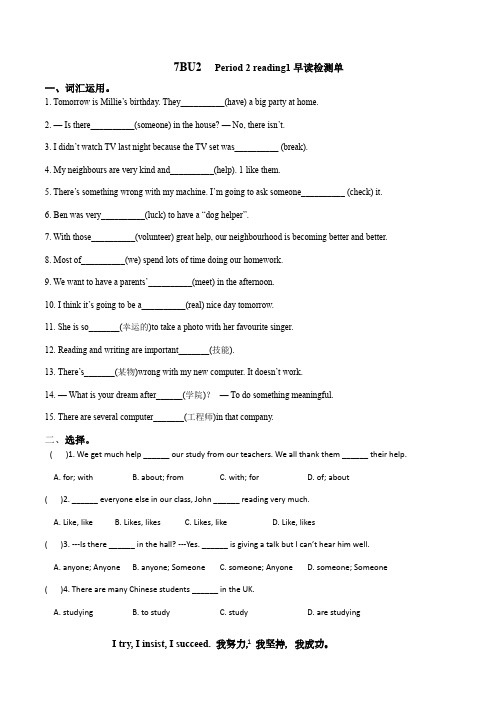
7BU2Period 2 reading1早读检测单一、词汇运用。
1. Tomorrow is Millie’s birthday. They__________(have) a big party at home.2. — Is there__________(someone) in the house? — No, there isn’t.3. I didn’t watch TV last night because the TV set was__________ (break).4. My neighbours are very kind and__________(help). 1 like them.5. There’s something wrong with my machine. I’m going to ask someone__________ (check) it.6. Ben was very__________(luck) to have a “dog helper”.7. With those__________(volunteer) great help, our neighbourhood is becoming better and better.8. Most of__________(we) spend lots of time doing our homework.9. We want to have a parents’__________(meet) in the afternoon.10. I think it’s going to be a__________(real) nice day tomorrow.11. She is so_______(幸运的)to take a photo with her favourite singer.12. Reading and writing are important_______(技能).13. There’s_______(某物)wrong with my new computer. It doesn’t work.14. — What is your dream after______(学院)?— To do something meaningful.15. There are several computer_______(工程师)in that company.二、选择。
新人教版七年级英语下册unit2(2a-2d)课件(ppt课件)

她工作从7点到9点。
8:00p.m. eight o’clock at night/in the evening
9.about / around 大约、大概
Rick usually goes to school at about / around 7:00
radio station
radio show
e学x习e交r流c课i件se go to work 7
Read the conversation in 2d. Fill in the
blanks.
Activities
time
at eight thirty at night
at nine
at about ten twenty
2. It’s time for sb. to do sth. 某人该做某事了/到了某人做某事的时间了
Eg:1.该吃午饭了。
It’s time for lunch.=It’s time to have/eat lunch.
2.到了你做家庭作业的时间了。
It’s time for you to do your homework.
according to your time
What time do syocuhedule.
usually get up?
I usually get up
at five fifty.
从未
早
Wow! I never get up so early.
学习交流课件
6
an interesting job funny
6:00 in the morning.
最新人教版初中七年级英语下册Unit 2 第二单元课件PPT

brush teeth
A: What time do you usually brush teeth? B: I usually brush teeth at…
2021/5/30
have breakfast A: What time do you usually have breakfast? B: I usually have breakfast at…
after he gets up.
orty
• 6. Twenty and twenty is f_______.
2021/5/30
What time is it?
nine o’clock
2021/5/30
What time is it?
twelve o’clock
2021/5/30
What time is it?
2021/5/30
Inter view your friends. Ask and answer questions about their day.
2021/5/30
Unit 2
What time do you go to school?
Section A
Period 3 Grammar Focus &(3a ~ 3c)
Unit 2 What time do you go to school?
Section A Period 1 1a ~ 1c
2021/5/30
根据句意及首字母提示填词。
• 1. After I get up at 6:00, I brush myeet th . • 2. —When do your familysuually eat dinner?
2024七年级英语下册Unit2Period2课件鲁教版五四制

I’m also going to brush my 16. ___t_e_e_t_h___ (tooth) after meals every day and wash my hands after going to the bathroom. As you know, a healthy lifestyle is necessary for everyone. 【点拨】brush one’s teeth 刷牙,应用tooth 的复数形式teeth。
【点拨】such as 例如;像,后面跟列举的一些内容。
I’m not going to 20. ____s_e_n_d___ (send) my own pictures to others or chat with someone online unless I get my parents’ permission (允许). 【点拨】be going to 后跟动词原形,故此处应用send。
3. More and more people think Chinese __m__e_d_i_ci_n_e___ (医学) is becoming more and more important.
4. __L_o_n_d_o_n__ (伦敦) is the capital (首都) of England.
My name is Dave. I’m going to eat fruit and vegetables every day. I want 15. __t_o_d_r_i_n_k__ (drink) more water and milk.
【点拨】want to do sth. 想要做某事,want 后接动词 不定式作宾语。
Unit 2 I’m going to study computer science.
英语人教PEP版七年级(上册)unit2sectionAperiod2(2024版新教材)

(grandparent).
8. Is t_h_i_s(these) your sister?
9. Theya_r_e_ (be) my father and mother.
10. Mr. Black has (有) threeb_r_o__th__e_rs (brother).
回答时常用H__e_’s_…__或__S_h_e_’_s_…__。 _w_h_o_’_r_e_ 是who are的缩写形式,用于对两个或两个 以上的人进行询问,回答时常用T__h_e_y_’r_e_…___。
强化练习
2c Ask and answer questions about the photo in 2b.
自学指导与检测一
1.Listen and circle the words you hear in the box. 2'
parents mother father sister brother
grandmother grandfather friends grandparents
2.Listen picture.
•
Kate, this is my friend Jane.
• Kate: Nice to meet you, Jane.
• Jane: Nice to meet you, too. Are those
•
your parents?
• Kate: Yes, they are.
• Jane: And who’s he?
3、学习相应的一般疑问句并简单作答 —Are those your parents? —Yes, they are.
七年级英语下册 Unit 2 Period 2课件 人教新目标版
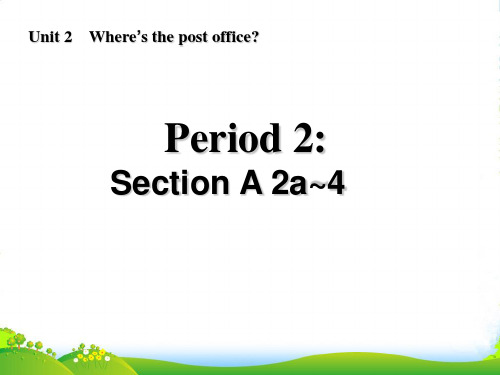
between… and…
Where is the pay phone? It’s between the post office and the library.
on
Where is the pay phone? It’s on the Green Street.
in front of
Where is the pay phone?
Homework
Make a conversation like 3a.
Yes, there is. Turn right, and go straight down Bridge Street. The post office is on the left. It’s across from the restaurant, next to the supermarket.
3a. Read and find Paul and Nancy in the picture.
Paul: Excuse me. Is there a hotel in the neighborhood?
Nancy: Yes, there is. Just go straight and turn left. It’s down Bridge Street on the right. It’s next to a supermarket.
It’s in front of the library.
behind
Where is the pay phone?
It’s behind the library.
2a. Match the sentences with the pictures
4
6
2
牛津译林版七下英语unit2neighbours知识点归纳
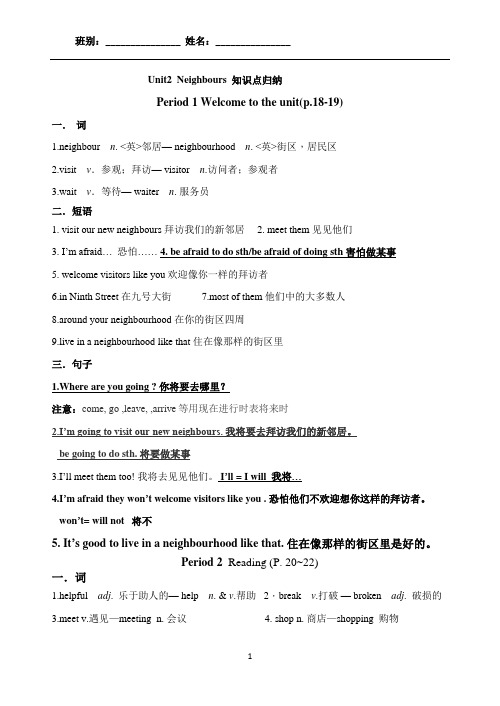
Unit2 Neighbours 知识点归纳Period 1 Welcome to the unit(p.18-19)一.词1.neighbour n. <英>邻居— neighbourhood n. <英>街区,居民区2.visit v.参观;拜访— visitor n.访问者;参观者3.wait v.等待— waiter n. 服务员二.短语1. visit our new neighbours 拜访我们的新邻居2. meet them 见见他们3. I’m afraid… 恐怕……4. be afraid to do sth/be afraid of doing sth 害怕做某事5. welcome visitors like you欢迎像你一样的拜访者6.in Ninth Street 在九号大街7.most of them 他们中的大多数人8.around your neighbourhood 在你的街区四周9.live in a neighbourhood like that 住在像那样的街区里三.句子1.Where are you going ? 你将要去哪里?注意:come, go ,leave, ,arrive等用现在进行时表将来时3.I’ll meet them too! 我将去见见他们。
I’ll = I will 我将…4.I’m afraid they won’t welcome visitors like you . 恐怕他们不欢迎想你这样的拜访者。
won’t= will not 将不5. It’s good to live in a neighbourhood like that. 住在像那样的街区里是好的。
Period 2 Reading (P. 20~22)一.词1.helpful adj. 乐于助人的— help n. & v.帮助 2.break v.打破— broken adj. 破损的3.meet v.遇见—meeting n. 会议 4. shop n. 商店—shopping 购物二.短语1.some of them 他们中的一些人2.meet at the community centre 在社区中心见面3.share their different skills 分享他们的不同技能4. help us with all kinds of problems 帮助我们解决各种的问题help sb. with sth. 帮助某人做某事5.have a “helping hands” meeting 举行“援助之手”见面会6.ask sb. (not) to do 要某人(不要)做某事7.ask someone to fix it 请某人修理它8. some college students 一些大学生9.be ready to help 乐意帮忙 be ready to do sth. 乐意做某事10.really nice 真好 11.help visit the old people 帮助看望老人12.do some shopping for them 为他们购物13.help the old people clean their flats 帮助老人打扫他们的公寓14.help the boy with his homework 帮助这个男孩做家庭作业15.fix things like broken bicycles 修理像坏了的自行车那样的物品16.need help with one’s problem 某人遇到问题需要帮助17.get help with one’s homework 某人作业得到帮助18.among the volunteers 在志愿者中二.句子1. What are your neighbours like? 你的邻居们怎么样? What be …like ? ...怎么样?2. They’re kind and helpful. 他们友好又乐于助人。
Unit2SectionA2a-2d课件人教版七年级英语下册
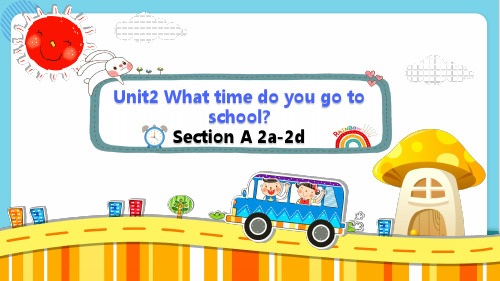
Let’s talk about Jim’s family. A: What time does… take a shower? B: He/She ……
Name Bob Mary Jack Jim Anna
Time 5:30 5:50 6:15 6:30 6:45
Talk about Miss Xu’s Day
TLaisskte1n75an2LdisRitmeonilteaa-ntpedl.amy athrek cwohnevreerstahteiosnp.eaker links. Production
Interviewer: Scott has an interesting job. He works at a radio station.
Yes, he does.
2. What time does Scott get up?
He gets up at 8:30 at night.
ReaPrdesienntgation Post-listening Read and answer.
2d Check your answers.
1. Does Scott have an interesting job? 2. Where does he Interviewer: Scott has an interesting job. Hweowrko?rks at a radio station. Scott, 3. When doeswhheawt toimrke? is your radio show?
Scott: At eight thirty at night. Then I eat breakfast at nine.
Interviewer: That's a funny time for breakfast!
2021年人教版七年级英语下册unit2 Section B2精品课件
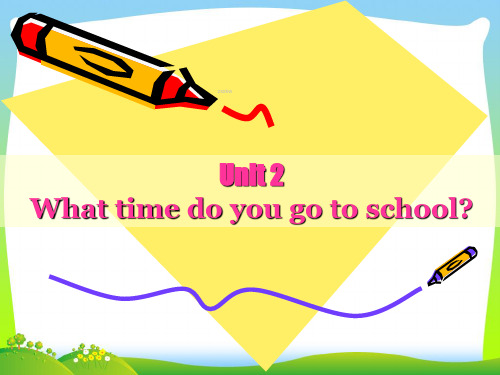
2b
zxxkw
Tony and Mary are brother and sister.
They have healthy and unhealthy
habits. Who is healthier? Circle the
healthy activities.
Hi! I’m Tony. I don’t zxxkw like to get up early. In the morning, I get up at eight. Then I go to school at eight thirty. I don’t have much time for breakfast, so I usually eat very quickly. For lunch, I usually eat hamburgers.
When does Tony usually go to bed?
zxxkw
Tony usually goes to bed at nine thirty.
Tony’s day .
zxxkw
zxxkw
Pair work A: When do people
usually eat dinner?
B: They usually eat dinner in the evening.
zxxkw
Tony
When does Tony usually get up?
zxxkw
Tony usually gets up at six o’clock.
When does Tony usually eat breakfast?
zxxkw
Tony usually eats breakfast at seven o’clock.
人教新目标英语七年级下册unit 2(第二课时)Period 2Section A 2a-3c课件

Student 1 Student 2 Student 3 Name:_____ Name: _____ Name: _____ get up on weekends exercise eat dinner take a shower go to school
正点 o’clock
to 30分钟以后
30分钟以内 past
刚好30分钟half past 1._点_钟_数_ o’clock 3. half past _点_钟_数__ 2. _分_钟数__ past __点钟_数__ 4. __差_分钟_数_ to _下_一_点_钟_数_
5. 15分钟 a quarter past _点钟_数_
5. What time does your best friend go to school? ________________________________
Pairwork Interview three of your classmates.
Find out what time they do these activities. Then give a report to the class.
Scott: From twelve o’clock at night to six o’clock in the morning.
Interviewer: What time do you _u_s_u_a_lly
get up?
Scott: At eight thirty at night. Then I eat b__re_a_k_f_a_stat nine.
七年级英语下册Unit2Period2

T: Is this your clock.(Point to the clock on the wall in theclassroom)
S: Yes, it is.
T: Yes, it’s our clock. Am I your teacher?
S: Yes, you are our teacher.( Help the students to answer.)
Then ask the students individually
T: What can you do?
S: I can dance.
T: Can you do it well?
S: Yes, I can. / No, I can’t.
5.Work on3b(完成P61,3b的对话部分)
T: Work on groups of four. Make upsimilardialogues. Please write down the answers in the form.
T: You know me well. Can I speak English?
S1: Yes, you can.
T: Yes, I can speak it very well. What else can I do?
S2: You can paint.
T: Yes, I can. But I can’t paint well.
英语俱乐部______________________艺术俱乐部________________________
音乐俱乐部______________________象棋俱乐部________________________
- 1、下载文档前请自行甄别文档内容的完整性,平台不提供额外的编辑、内容补充、找答案等附加服务。
- 2、"仅部分预览"的文档,不可在线预览部分如存在完整性等问题,可反馈申请退款(可完整预览的文档不适用该条件!)。
- 3、如文档侵犯您的权益,请联系客服反馈,我们会尽快为您处理(人工客服工作时间:9:00-18:30)。
seven o’clock.
have breakfast A: What time do you usually have breakfast? B: I usually have breakfast at
seven fifteen./a quarter past seven
go to school A: What time do you usually go to school?
她每天六点钟去上班。
work She goes to _____ at six o’clock.
2. That’s a funny time for breakfast! time常常和介词“for”搭配,表示“做 ……的时间”。如: We don’t have too much time for sports. 我们没有太多的时间开展体育活动。 Time for dinner, children. Go and wash your hands, please. 孩子们,饭好了。去洗手吧。
作可数名词,意为“体操;(技能)练 习”。 我们每天做早操。 exercises We do morning ________ every day.
4. station 意为“电(视)台;车站” 如: TV station 电视台 bus station 公交车站
5. o’clock 意为 “… …点钟”,跟在整点后 如:七点钟 seven o’clock 6. funny意为“奇怪的;滑稽好笑的”。 詹妮是一位滑稽的女孩。 funny Jenny is a ______ girl. 7. be late for 意为“做„„迟到” 汤姆经常上学迟到。 late for Tom is always ____ ____ school.
have breakfast A: What time does he usually have breakfast? B: He usually has breakfast at
seven fifteen./a quarter past seven
brush teeth
A: What time does she usually brush teeth? B:She usually brushes teeth at
does homework
B: He usually ____________ at 5:30.
9:20
go to bed
A:What time does she usually __________?
go to bed
B:She usually __________at nine
twenty.
goes to bed
⑶usually 意为“通常” “平常” ,即很少有例 外 他通常十点钟上床睡觉 ep:He usually goes to bed at ten’o
clock.
⑷sometimes 意为“有时候” ,表示动作偶尔发 生。可以位于句首,以示强调
ep:It is sometimes hot and sometimes cold.
天气忽冷忽热。
What time is your radio show?
你的广播节目在什么时间?
From twelve o’clock at night to six o’clock in the morning.
辨析:never,always,usually与sometimes
• ⑴never 意为“从不;决不”
ep:My parents are never late for work . 我父母上班从来不迟到
⑵always 意为“总是” “永远地”,表示动 作重复或者状态持续,中间没有间断
ep:The sun always rises in the east and sets in the west. 太阳总是东升西落。
seven o’clock.
get dressed A: What time does he usually get dressed? B: He usually gets dressed at
six fifty./ten to seven .
take a shower A: What time does he usually take a shower? B: He usually takes a shower at
3. exercise 的用法小结 作动词,意为“锻炼”。如: 他爷爷每天早晨锻炼。 exercises His grandpa _________ in the morning. 作不可数名词,意为“锻炼;运动”, take exercise 是固定搭配,意思是“进 行锻炼”。如: Take more exercise, and you will be healthy.每天他都做大约十五分钟的运动。 He does about fifteen minutes’ ________ every day. exercise
1. job与work 辨析 job是可数名词, 主要指有报酬的工作
work是不可数名词, 主要指要付出努
力 的劳动
鲍勃想找一份好的工作。
job Bob wants to find a good ____.
今天我有很多工作要做。
work I have much _____ to do today.
9.best:最好的
• best 是good 的最高级;形容词最高级前通 常用the或形容词性物主代词等作限定。 • Mr. Wang is our best teacher. • Lily is the best student in our class. • 英语的形容词与副词有三个级:原级、比 较级和最高级。 • good\well better best
8. always 意为“总是,一直” usually 意为“通常地,一直地” 频率词 never 意为“从未,绝不” I usually (通常) get dressed at six forty. _______ Jack is always (总是) late. _______ His grandpa _______ (从未) goes to school. never
six forty. / twenty to seven .
go to school A: What time do they usually go to school?
B: They usually go to school at
seven thirty./half past seven.
重点句型:
Unit 2 What time do
you go to school
SectionA (1a-3a)
Ask and answer in pairs
7:00 7:05 7:10 7:15 7:25 7:30 7:35 7:40 7:45 7:50
seven/seven o’clock seven five/five past seven seven ten/ten past seven seven fifteen/a quarter past seven seven twenty-five/twenty-five past seven seven thirty/ half past seven seven thirty-five/twenty-five to eight seven forty/ twenty to eight seven forty-five/a quarter to eight seven fifty/ten to eight
• • • • • • • • • • • • • • •
never 从不 早(的) early 五十 fifty 职业 Job 工作 work 电(视)台 station 车站 广播电台 radio station 点钟 o’clock 夜晚 night 滑稽好笑的 funny 锻炼 exercise 在周末 on weekends 最好的 best 组,群 group
fifteen.
get dressed
A: What time do you usually…?
B: I usually ….at…
brush teeth
go to school
get up
do homework
get dressed take a shower play sports eat breakfast
B: I usually go to school at
seven thirty./half past seven.
8:15
get dressed
A:What time do they usually ______? B:They usually__________at eight
get dressed
He goes to school at 7:00.
否定句
He doesn’t go to school at 7:00.
一般疑问句
Does he go to school at 7:00? Yes, he does. No, he doesn’t. What time does he usually go to school?
I go to school at 7:00.
否定句
I don’t go to school at 7:00.
一般疑问句
Grammar Focus
Do you go to school at 7:00. Yes, I do. No, I don’t.
What time do you usually go to school?
